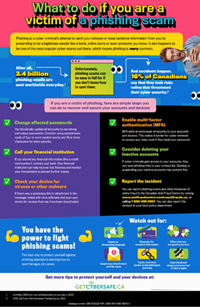
After all, 3.4 billion phishing emails are sent every day.footnote 1
Unfortunately, phishing scams can be easy to fall for if you don’t know how to spot them.
And accidents happen. 18% of Canadians say that they took risks online that threatened their cyber security.Footnote 2
 If you become a victim of phishing, here are simple steps you can do to recover and secure your accounts and devices:
If you become a victim of phishing, here are simple steps you can do to recover and secure your accounts and devices:-
✅ Change affected passwords
You should also update all accounts to use strong and unique passwords. Consider using passphrases made of four or more random words and 15 or more characters for extra security.
-
✅ Enable multi-factor authentication (MFA)
MFA adds an extra layer of security to your accounts and devices. This makes it harder for cyber criminals to access your data, even if they steal your password.
-
✅ Call your financial institution
If you shared any financial information (like a credit card number), contact your bank. You can recover lost finances and prevent any further losses, while monitoring your transactions.
-
✅ Consider deleting your inactive accounts
If cyber criminals gain access to your accounts, they can send phishing links to your contact list. Deleting or suspending your inactive accounts may prevent this.
-
✅ Check your device for viruses or other malware
If there was a suspicious link or attachment in the email, install anti-virus software and scan your device for viruses that may have been downloaded.
-
✅ Report the incident
You can report phishing scams and other instances of online fraud to the Canadian Anti-Fraud Centre, or calling 1-888-495-8501. You can also report the incident to your local police department.

You have the power to fight phishing scams!

The best way to protect yourself against phishing attempts is learning how to spot the signs of a scam.

Urgent or threatening language
Requests for sensitive information
Offers that are too good to be true
Suspicious attachments and file types
Typos, incorrect sender email addresses and links
Unprofessional design and incorrect or blurry logos

